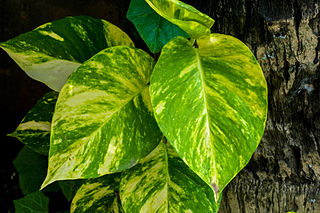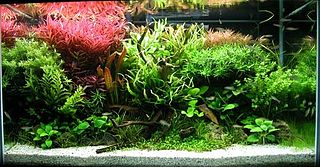
Epipremnum aureum is a species in the arum family Araceae, native to Mo'orea in the Society Islands of French Polynesia. The species is a popular houseplant in temperate regions but has also become naturalised in tropical and sub-tropical forests worldwide, including northern South Africa, Australia, Southeast Asia, South Asia, the Pacific Islands and the West Indies, where it has caused severe ecological damage in some cases.

The neon tetra is a Freshwater fish of the characin family of order Characiformes. The type species of its genus, it is native to blackwater and clearwater streams in the Amazon basin of South America. Its bright colouring makes the fish visible to conspecifics in the dark blackwater streams, and is also the main reason for its popularity among freshwater fish hobbyists, with neon tetras being one of the most widely kept tropical fish in the world.
Community aquaria are tanks that are designed to contain more than one species of fish. Most commonly they include a variety of species that do not normally occur together in nature, for example angelfish from Brazil, swordtails from Mexico, and gouramis from South East Asia. The aim of such communities is to bring together fish that are compatible in temperament and water requirements, while using their different colours and behaviors to add interest and entertainment value.

The dwarf gourami is a species of gourami native to South Asia.

Aquascaping is the craft of arranging aquatic plants, as well as rocks, stones, cavework, or driftwood, in an aesthetically pleasing manner within an aquarium—in effect, gardening under water. Aquascape designs include a number of distinct styles, including the garden-like Dutch style and the Japanese-inspired nature style. Typically, an aquascape houses fish as well as plants, although it is possible to create an aquascape with plants only, or with rockwork or other hardscape and no plants.

Taxiphyllum barbieri, known as Java moss or Bogor moss, is a moss belonging to the family Hypnaceae. Native to southeast Asia, it is commonly used in freshwater aquariums. It attaches to rocks, roots, and driftwood. In the wild, it grows in humid riparian areas.

Corydoras panda is a species of catfish belonging to the genus Corydoras, of the family Callichthyidae, and is a native member of the riverine fauna of South America. It is found in Peru and Ecuador, most notably in the Huanaco region, where it inhabits the Rio Aquas, the Rio Amarillae, a tributary of the Rio Pachitea, and the Rio Ucayali river system. The species was first collected by Randolph H. Richards in 1968, and was named Corydoras panda by Nijssen and Isbrücker in 1971. The specific name is an allusion to the appearance of the fish, which possesses large black patches surrounding the eyes, reminiscent of those found on the giant panda. Accordingly, the common names for this fish, which is a popular aquarium species, are panda corydoras and panda catfish.

Hemigrammus erythrozonus, commonly known as the glowlight tetra, is a small tropical fish from the Essequibo River, Guyana, South America. It is silver in colour and a bright iridescent orange to red stripe extends from the snout to the base of its tail, the front of the dorsal fin being the same color as the stripe. Other fins are silver to transparent. The glowlight tetra is a peaceful, shoaling fish. It is larger than the neon tetra, and its peaceful disposition makes it an ideal, and popular, community tank fish. It should be kept with similar sized, non-aggressive species. Hemigrammus gracilis is a senior synonym. The red-line rasbora of Malaysia and Indonesia has markings and coloring very similar to H. erythrozonus, but is a member of family Cyprinidae, not a close relative.

The Siamese algae-eater is a species of freshwater fish in the carp family, Cyprinidae. This bottom-dwelling tropical fish is found in mainland Southeast Asia, including the Chao Phraya and Mekong basins as well as the Malay Peninsula. Its natural habitats are streams and rivers as well as flooded forests during the rainy season. The Siamese algae-eater should not be confused with the flying fox or the false siamensis , lacking the distinctive black bands of the former.

The Sunda scops owl is a small brown owl native to the Sunda Islands.

Lomariopsis lineata is a species of fern native to South East Asia. The prothallia of this species are commonly cultivated as an aquarium plant, where it is known to aquarists as süsswassertang. It is often incorrectly spelled "subwassertang" due to the German eszett's similarity to the Latin 'B'. It is also called Loma fern or round pellia.
Jean Étienne Duby was a Swiss clergyman and botanist.
Vesicularia montagnei is a species of moss. It is used in planted aquariums as an ornamental underwater plant, commonly referred to as Christmas moss.

Fontinalis antipyretica, greater water-moss, or common water moss, is a species of submerged aquatic moss belonging to the subclass Bryidae. It is found in both still and flowing freshwater in Europe, Asia, Greenland and Africa. In North America it is found in most Canadian provinces with a seaboard and most US states except the most southern.

Red Devil Vampire Crabs are decapod crustaceans part of Brachyura.

Geosesarma dennerle is a species of small land-living crabs found on Java, Indonesia.

Taxiphyllum is a genus of mosses in the family Hypnaceae.
Vesicularia is a genus of mosses belonging to the family Hypnaceae.
Java moss is a common name for several plants and may refer to:













